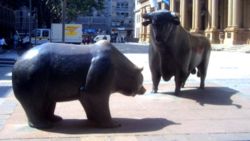Here is a quick definition of bull and bear market. I haev heard these terms so often, but hardly had the time to check!!
In the investment arena, financial markets are commonly believed to have market trends that can be classified as primary trends, secondary trends (short-term), and secular trends (long-term).
Primary trend: A bull market is a prolonged period of time when prices are rising in a financial market faster than their historical average, in contrast to a bear market which is a prolonged period of time when prices are falling. Investors can be described as having bullish (bull = buy) or bearish (bear = sell) sentiments. Upward market trends are witnessed when bulls (buyers) outnumber bears (sellers) - downward for vice versa.

Secondary trend: A secondary trend is a temporary change in price within a primary trend. These usually last a few weeks to a few months. A temporary decrease during a bull market is called a correction; a temporary increase during a bear market is called a bear market rally.
A secular market trend is a long-term trend that lasts 5 to 20 years, and consists of sequential primary trends. In a secular bull market the bear markets are smaller than the bull markets. Typically, each bear market does not wipe out the gains of the previous bull market, and the next bull market makes up the losses of the bear market. Vice versa for secular bear market.

No comments:
Post a Comment